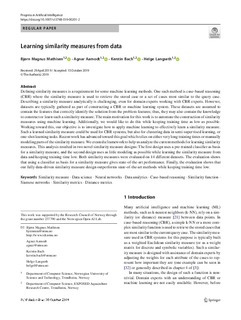| dc.contributor.author | Mathisen, Bjørn Magnus | |
| dc.contributor.author | Aamodt, Agnar | |
| dc.contributor.author | Langseth, Helge | |
| dc.contributor.author | Bach, Kerstin | |
| dc.date.accessioned | 2020-01-30T11:42:55Z | |
| dc.date.available | 2020-01-30T11:42:55Z | |
| dc.date.created | 2019-11-27T13:52:14Z | |
| dc.date.issued | 2019 | |
| dc.identifier.citation | Progress in Artificial Intelligence. 2019, 1-15. | nb_NO |
| dc.identifier.issn | 2192-6352 | |
| dc.identifier.uri | http://hdl.handle.net/11250/2638837 | |
| dc.description.abstract | Defining similarity measures is a requirement for some machine learning methods. One such method is case-based reasoning (CBR) where the similarity measure is used to retrieve the stored case or a set of cases most similar to the query case. Describing a similarity measure analytically is challenging, even for domain experts working with CBR experts. However, datasets are typically gathered as part of constructing a CBR or machine learning system. These datasets are assumed to contain the features that correctly identify the solution from the problem features; thus, they may also contain the knowledge to construct or learn such a similarity measure. The main motivation for this work is to automate the construction of similarity measures using machine learning. Additionally, we would like to do this while keeping training time as low as possible. Working toward this, our objective is to investigate how to apply machine learning to effectively learn a similarity measure. Such a learned similarity measure could be used for CBR systems, but also for clustering data in semi-supervised learning, or one-shot learning tasks. Recent work has advanced toward this goal which relies on either very long training times or manually modeling parts of the similarity measure. We created a framework to help us analyze the current methods for learning similarity measures. This analysis resulted in two novel similarity measure designs: The first design uses a pre-trained classifier as basis for a similarity measure, and the second design uses as little modeling as possible while learning the similarity measure from data and keeping training time low. Both similarity measures were evaluated on 14 different datasets. The evaluation shows that using a classifier as basis for a similarity measure gives state-of-the-art performance. Finally, the evaluation shows that our fully data-driven similarity measure design outperforms state-of-the-art methods while keeping training time low. | nb_NO |
| dc.language.iso | eng | nb_NO |
| dc.publisher | Springer Verlag | nb_NO |
| dc.relation.uri | https://link.springer.com/content/pdf/10.1007%2Fs13748-019-00201-2.pdf | |
| dc.rights | Navngivelse 4.0 Internasjonal | * |
| dc.rights.uri | http://creativecommons.org/licenses/by/4.0/deed.no | * |
| dc.subject | Case-basert resonnering | nb_NO |
| dc.subject | Case-based reasoning | nb_NO |
| dc.subject | Kunstig intelligens | nb_NO |
| dc.subject | Artificial intelligence | nb_NO |
| dc.subject | Maskinlæring | nb_NO |
| dc.subject | Machine learning | nb_NO |
| dc.title | Learning similarity measures from data | nb_NO |
| dc.type | Journal article | nb_NO |
| dc.type | Peer reviewed | nb_NO |
| dc.description.version | publishedVersion | nb_NO |
| dc.subject.nsi | VDP::Datateknologi: 551 | nb_NO |
| dc.subject.nsi | VDP::Computer technology: 551 | nb_NO |
| dc.source.pagenumber | 1-15 | nb_NO |
| dc.source.journal | Progress in Artificial Intelligence | nb_NO |
| dc.identifier.doi | 10.1007/s13748-019-00201-2 | |
| dc.identifier.cristin | 1753104 | |
| dc.relation.project | Norges forskningsråd: 237790 | nb_NO |
| dc.description.localcode | Open Access This article is distributed under the terms of the Creative Commons Attribution 4.0 International License (http://creativecommons.org/licenses/by/4.0/), which permits unrestricted use, distribution, and reproduction in any medium, provided you give appropriate credit to the original author(s) and the source, provide a link to the Creative Commons license, and indicate if changes were made. | nb_NO |
| cristin.unitcode | 194,63,10,0 | |
| cristin.unitname | Institutt for datateknologi og informatikk | |
| cristin.ispublished | true | |
| cristin.fulltext | original | |
| cristin.qualitycode | 1 | |

